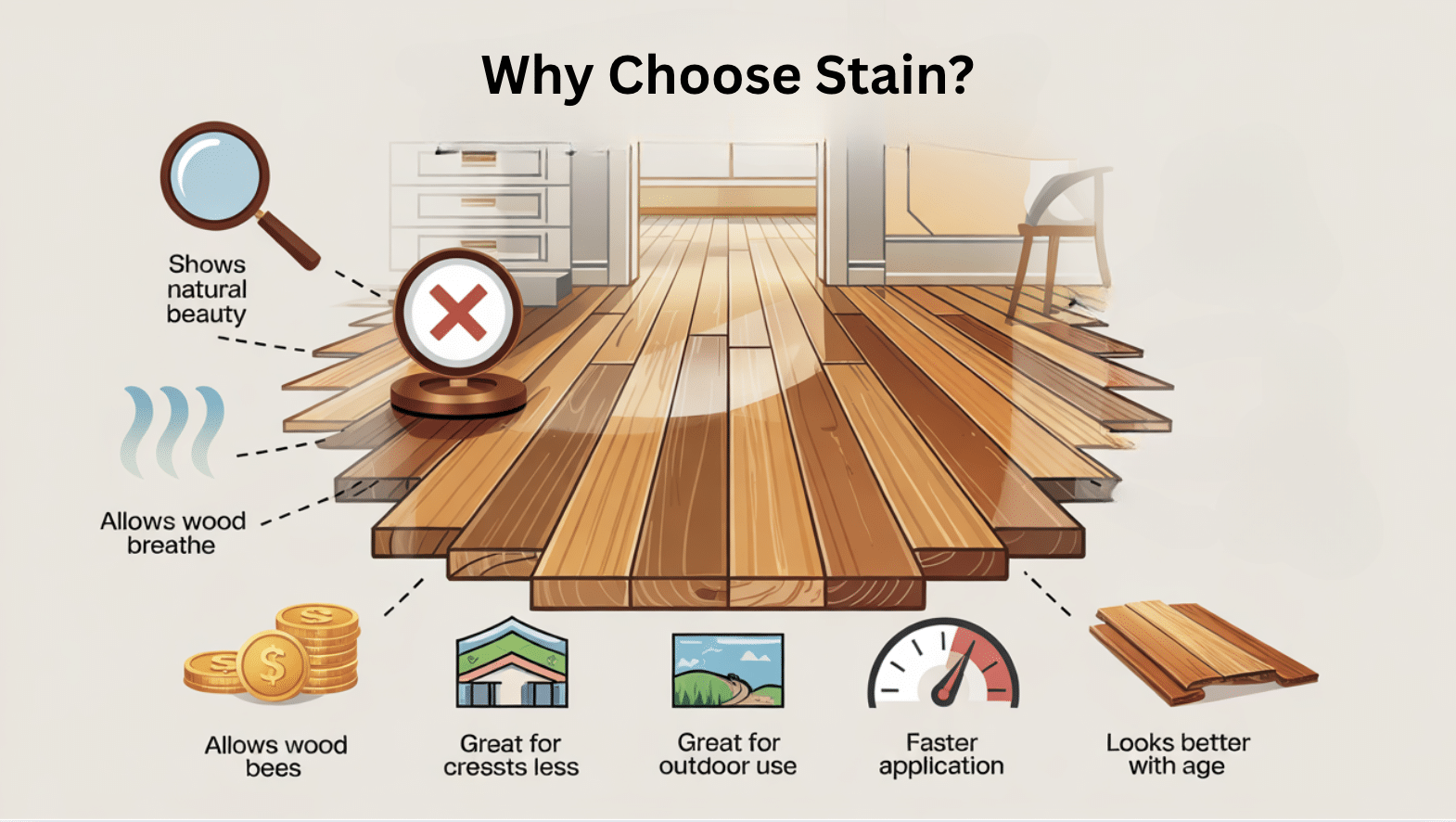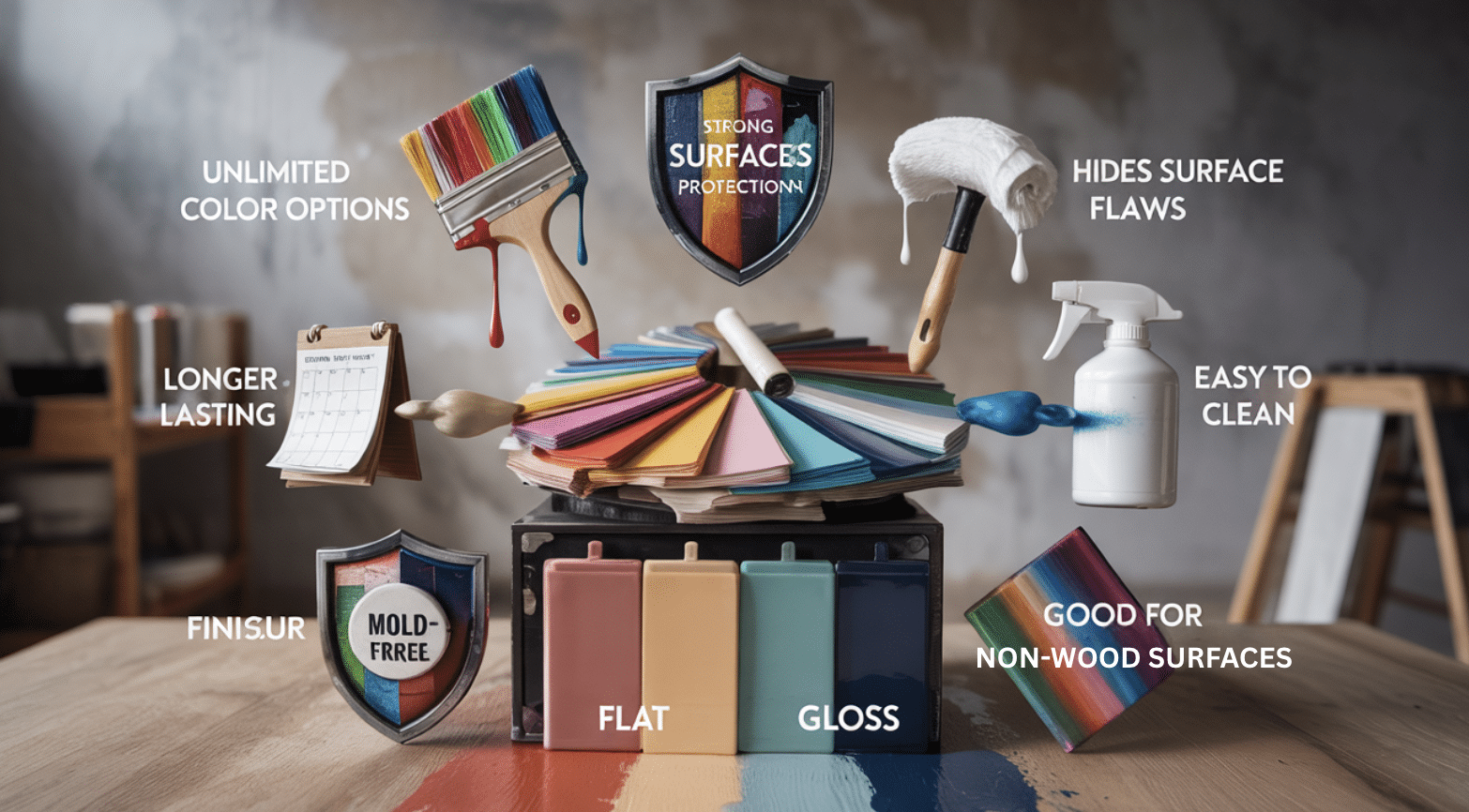Looking to refresh your home with a new finish but unsure whether to choose stain or paint? I frequently encounter this question from homeowners.
Is your wooden furniture looking tired? Are your cabinets faded? Perhaps your deck needs a makeover? The right finish can change your space, but the wrong choice might leave you with regret and extra work.
I know how frustrating it feels to spend time and money on a project only to wish you’d gone the other direction. Having tried both options on various projects, I’ve learned what works best in different situations.
In this guide, I’ll walk you through exactly what makes stain and paint different, when to use each one, and how to avoid the common mistakes that lead to disappointing results. By the end, you’ll feel confident about which option is truly right for your next project.
Stain vs Paint: Which One is Right for You?
Choosing between stain and paint can significantly impact the outcome of your project. The right pick depends on what you want the final look to be and how much effort you’re willing to put into it later on.
This guide will help you pick the best option for your needs. Let’s look at what makes each one special and when to use them.
Stain vs Paint: Understanding the Basics
When working on wood projects, understanding the difference between stain and paint is crucial for achieving the desired results.
What is Stain?
Stain is a thin liquid that soaks into wood. It changes the color while still showing the wood’s natural patterns. Stains are available in clear, semi-transparent, or opaque types.
What is Paint?
Paint is a thick liquid that sits on top of surfaces. It creates a solid layer of color that covers everything underneath. Paint comes in various finishes, including flat, satin, and glossy.
The main difference is simple: stain becomes part of the wood, while paint covers it up. This affects how your project will appear and its expected lifespan.
Why Choose Stain? (Advantages and Ideal Uses)

- Shows natural wood beauty: Stain lets you see all the unique patterns in each piece of wood while adding color.
- Less prep work needed: You often don’t need to sand as much or use primer before applying stain to wood.
- Easy touch-ups: You can fix small worn areas without having to redo the entire surface.
- Allows wood to breathe: Stain lets moisture move through the wood instead of trapping it inside.
- Often costs less: Many stain products are less expensive per square foot than quality paints.
- Great for outdoor use: The stain moves with the wood as it expands and contracts with weather changes.
- Faster application: You can often finish a staining project in less time than a painting one.
- Looks better with age: Many stains develop a nice worn look over time rather than just wearing out.
Why Choose Paint? (Advantages and Ideal Uses)

- Unlimited color options: Paint comes in thousands of shades, from soft whites to deep blacks and every color in between.
- Strong surface protection: Paint creates a hard shell that blocks water, sun damage, and daily wear and tear.
- Hides surface flaws: Paint can cover small cracks, old stains, or uneven spots without costly repairs first.
- Longer-lasting finish: Quality paint can last 5-10 years on exterior surfaces before needing a refresh.
- Easy to clean: Painted surfaces, especially in glossy finishes, can be wiped clean of dirt and marks.
- Mold and mildew resistant: Many paints now include formulas that fight the growth of mold in damp areas.
- Specific finishes available: You can choose flat, eggshell, satin, semi-gloss, or high-gloss to match your needs.
- Good for non-wood surfaces: Paint works well on metal, plastic, brick, and many other materials.
The Downsides of Stain: What You Should Know
- Problem: Limited Color Selection
Stain comes mostly in wood tones and natural shades. If you want bright colors or specific design shades, you’ll be disappointed by the small range of options compared to paint. - Problem: Needs More Frequent Maintenance
Most stained surfaces require reapplication every 1-3 years, especially outdoors. Sun and rain break down stain faster than paint, making ongoing care a regular commitment. - Problem: Shows Every Wood Flaw
Stain makes every knot, scratch, and imperfection more visible. While this enhances good grain patterns, it also highlights dents, patches, and less attractive wood features. - Problem: Less Protection Against Damage
Stain doesn’t shield surfaces as well as paint does. It offers less protection against water, scratches, stains, and general wear, leaving wood more open to damage. - Problem: Can Apply Unevenly
Some woods take stain unevenly, creating blotchy areas. Pine, maple, and birch are known for this problem, which can make finished projects look amateur despite careful work. - Problem: Harder to Clean
Stained surfaces, especially those with open grain, collect dirt and dust more easily than smooth painted surfaces. This makes them harder to wipe clean in high-use areas.
The Downsides of Paint: What You Should Know
- Problem: Cracking and Peeling
Paint creates a hard surface that doesn’t flex with wood. When wood expands or contracts due to humidity and temperature, paint can crack and peel. This happens most often on outdoor items like decks, fences, and siding. - Problem: Hides Natural Wood Beauty
Once you paint wood, you cover all its natural grain and character. This change is nearly permanent – if you later want to see the wood grain, you’ll need extensive stripping, sanding, and refinishing work. - Problem: Challenging Touch-ups
Fixing small areas of painted surfaces can be tricky. Paint fades and changes color over time, so new paint rarely matches the old exactly. Small repairs often stand out as visible patches against the older paint. - Problem: Extensive Prep Work Required
Painting demands more preparation than staining. You need to clean, sand, prime, and typically apply multiple coats. Each step requires drying time, making painting projects take days or even weeks to complete. - Problem: Potential Moisture Trapping
Paint seals surfaces and can trap moisture in wood if not properly prepared. This trapped moisture may lead to rot, mildew, and early wood failure in some settings, especially in high-humidity areas. - Problem: Higher Initial Cost
Quality paint and primers cost more upfront than most stains. When you factor in the need for multiple products (primer, multiple coats), painting becomes a more expensive initial investment.
Stain vs Paint: A Head-to-Head Comparison
| Feature | Stain | Paint |
|---|---|---|
| Color Options | Limited (mostly wood tones) | Unlimited (thousands of colors) |
| Application Method | Soaks into wood | Forms layer on top |
| Durability | 1–3 years typically | 5–10 years typically |
| Maintenance Needs | More frequent reapplication | Less frequent touch-ups |
| Appearance | Shows wood grain | Hides wood grain |
| Protection Level | Moderate | High |
| Flexibility | Moves with wood | It can crack when wood moves |
6 Common Mistakes to Avoid When Choosing Stain or Paint
1. Picking Based on Looks Alone
Many people choose stain or paint based only on how it will look on day one. This often leads to regret when the finish fails to hold up over time. Consider both the initial look and how well it will work for your specific situation long-term.
2. Skipping the Sample Test
Not testing stain or paint on a small, hidden area first is a common error. Colors often look different on actual wood than they do on color cards or in the can. Always test on a scrap piece of the same wood or in an out-of-sight spot.
3. Ignoring Surface Preparation Needs
Both stain and paint require proper surface prep, but in different ways. Many DIYers don’t sand enough before staining or skip primer before painting. These shortcuts lead to poor results and early failure of the finish.
4. Not Thinking About Weather Exposure
Using indoor paint for outdoor projects or not considering how much sun, rain, or snow will hit the surface is a major mistake. Some areas need specific types of stain or paint to hold up against their local climate conditions.
5. Overlooking Maintenance Requirements
People often forget to think about future care when choosing. Stain typically needs more frequent touch-ups but is easier to reapply. Paint lasts longer but requires more work when it’s time to redo it. Plan for the maintenance you’re willing to do.
6. Using the Wrong Type for Your Surface
Not all stains work on all woods, and not all paints work on all surfaces. Using deck stain on furniture or wall paint on a floor will lead to poor results. Always check that your product is made for your specific application.
Which One Is Better For You: Final Recommendations
After weighing all factors, here are the definitive recommendations for choosing between stain and paint.
Choose Stain When
- Highlighting natural wood grain is the priority
- The project is outdoors, where wood needs to breathe
- The surface is new or in good condition
- Budget constraints exist for initial project costs
- Easy touch-ups are desired
- The item will be refinished or changed within 1-3 years
- Application time needs to be minimized
- The wood has attractive natural patterns worth showcasing
Choose Paint When
- Maximum protection against wear, water, and damage is essential
- Specific or bright colors are required
- The surface has flaws, stains, or damage to hide
- Long-term durability (5-10 years) is needed
- Easy cleaning is important (kitchens, bathrooms, high-traffic areas)
- The project involves non-wood surfaces or mixed materials
- Mold and mildew resistance matters
- Professional-looking, uniform finish is the goal
Conclusion
Your choice between stain and paint comes down to what matters most for your specific project.
Choose a stain when you value the natural look of wood and don’t mind regular upkeep. It’s ideal for projects that require highlighting wood grain and creating a warm, natural ambiance.
Go with paint when you need specific colors, maximum protection, or want to hide flaws. Paint offers durability and less frequent maintenance, but at the cost of covering the wood’s natural character.
Remember to test your choice on a small area first, prepare surfaces properly, and think about long-term maintenance before starting.
Whether you choose stain or paint, the right preparation makes all the difference in getting results you’ll be happy with for years to come.
What’s your next project? Which option fits your needs better?
Frequently Asked Questions
What Lasts Longer, Paint or Stain?
Paint typically lasts longer than stain. High-quality paint can last 5-10 years on exterior surfaces, while stain typically requires reapplication every 1-3 years, especially outdoors.
Why Use Stain Over Paint?
Use stain when you want to show off the wood’s natural grain and patterns. It’s easier to apply, requires less preparation, and allows wood to breathe naturally.
Will Stain Dry if You Don’t Wipe It Off?
The stain will dry if you don’t wipe it off, but it will likely look blotchy and uneven. The surface may feel sticky or tacky for an extended period, and the finish won’t be as smooth.


